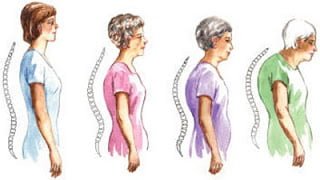Why You Should Be Improving Your Back Posture
 Oh posture! It’s that thing we all know we need to focus on a bit more but bad habits, a sedentary lifestyle, our work environment and even genetics sometimes get in the way. Last month was National Posture Awareness Month – and I shared the importance of good neck posture for avoiding negative health effects. But the neck is only one aspect of posture – improving your back posture in the upper and middle back, or thoracic spine, is equally important.
Oh posture! It’s that thing we all know we need to focus on a bit more but bad habits, a sedentary lifestyle, our work environment and even genetics sometimes get in the way. Last month was National Posture Awareness Month – and I shared the importance of good neck posture for avoiding negative health effects. But the neck is only one aspect of posture – improving your back posture in the upper and middle back, or thoracic spine, is equally important.
The most common problem with posture of the thoracic spine is increased kyphosis, or “hunching.” The thoracic spine should be shaped like a “C” with the inside of the curve facing the front of the body and the arch of the curve going from the middle of the back toward the upper back. As this curve increases, a person will go from being slouched to severely hunched forward over time. Hyperkyphosis can restrict breathing and actually reduce heart and lung function, impacting life expectancy.
Common Causes of Kyphosis
Osteoporosis (especially in women)
The bones of the spine are like stacked building blocks, creating a column supporting the body. As they start to break down in the front of the thoracic spine, they become shaped more like wedges. This makes the bones shorter in the front and taller in the back so as they are stacked upon each other, and the curve becomes exaggerated.
Arthritic Changes
The discs, or the cushiony shock absorbers between the bones of the spine, start to wear out and lose their height. As the discs dry out and shrink with wear and tear, this changes how the bones stack upon each other and increases kyphosis.
Poor Muscle Tone
I believe this is unfortunately a very overlooked cause. Have you ever noticed that dancers, yoga instructors and Pilates instructors have great posture? Well, there is a reason! One has to actually exercise and strengthen postural muscles to allow them to hold your spine in the proper posture. Weak postural muscles are becoming a bigger and bigger problem as people of all ages spend an increasing large amount of time in poor positions on computers and smart devices.
Fixation and Rigidity
Finally, fixation and rigidity in the thoracic spine can throw off the normal posture, as the bones are not able to move properly upon each other. This can also affect the ability of the ribs to move on their articulations with the spine during breathing. Many patients will say that it feels painful or difficult to stand straight and tall. Often this is caused by rigidity between the shoulder blades and is greatly improved with chiropractic adjustments.
Tips to Prevent Hyperkyphosis
- Take a maintenance dose of 2000 IU of vitamin D daily if you are within normal D range and at least 4000 IU of vitamin D to build your levels if you are low. This will help keep your bones strong and healthy preventing osteoporosis.
- Include exercises that strengthen your upper back in your work out routine. Rowing, thoracic extension or any kind of exercise that brings your shoulder blades together is great. Since this can be difficult, I encourage you to start under the supervision of a professional so you don’t injure yourself trying to learn how to strengthen the muscles in this part of the back.
- Take a yoga class! Yoga practice automatically strengthens postural muscles.
- Check the ergonomics of your workstation.
- Limit time spent on smart devices.
- And of course, get a chiropractic evaluation to make sure your spine is flexible and healthy!
I love this video for strengthening the postural muscles of the back. Some of you would not be able to do this exercise because getting on the floor is too difficult due to upper back weakness, or you have bad knees, or are simply too weak to lift into the proper position. No worries, we have some simpler exercises to you improving your back posture that can be done in a chair!
Dr. Sharman


Write a Comment